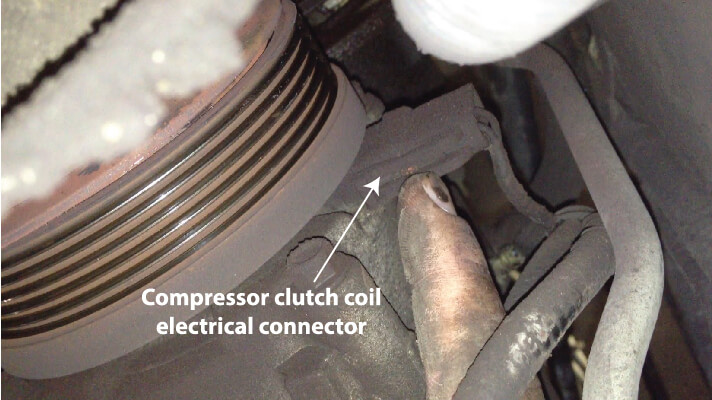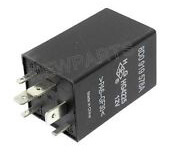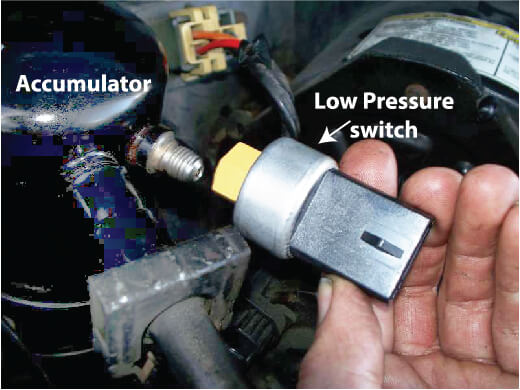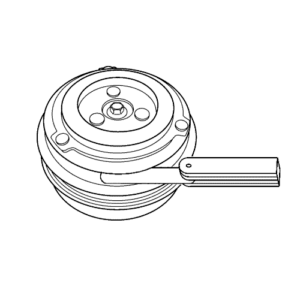The compressor clutch won’t engage if:
- Share
- publisher
- HELEN
- Issue Time
- May 20,2020
Summary
The compressor clutch won’t engage if:

The clutch fuse is blown. The most common cause of a blown clutch fuse is a short to ground in the compressor clutch coil. To test for a short to ground, set a multimeter to the ohms scale and touch one lead to a clutch coil terminal and the other to a ground point on the compressor. You should see no conductance.
 Then switch to the other clutch coil terminal and check for short to ground. Finally, attach both leads to the two clutch coil terminals and compare the resistance reading to factory specifications. If the reading is too low, that’s an indication of a short between coil windings. That would result in a weak magnetic field that prevents full clutch plate to pulley engagement.
Then switch to the other clutch coil terminal and check for short to ground. Finally, attach both leads to the two clutch coil terminals and compare the resistance reading to factory specifications. If the reading is too low, that’s an indication of a short between coil windings. That would result in a weak magnetic field that prevents full clutch plate to pulley engagement.
The clutch relay is faulty. The electrical contacts in the AC clutch relay  can develop pitting that prevent full current flow to the clutch coil, resulting in no clutch engagement. To test, unplug the electrical connector at the clutch coil and test for battery voltage with the AC turned on.
can develop pitting that prevent full current flow to the clutch coil, resulting in no clutch engagement. To test, unplug the electrical connector at the clutch coil and test for battery voltage with the AC turned on.
System pressure is too low. Low pressure indicates a low refrigerant charge. If the compressor operates with a low refrigerant charge, the system won’t carry enough oil to the compressor, causing it to fail. That’s why you should NEVER jump across a low pressure switch to force the AC compressor to engage.
The low pressure switch is installed on the low pressure line or right on the accumulator.

System pressure is too high. Starting the AC compressor against high pressure, whether due to an overcharge condition or a restricted component can damage the clutch and compressor. The high pressure switch is located on a high pressure line or right on the receiver/dryer.
The clutch coil ground is corroded. A corroded ground connection will prevent the clutch coil from generating a magnetic field, resulting in a compressor clutch won’t engage situation. Remove the electrical connector from the clutch coil and check for good ground using a multimeter.
The heater control or PCM isn’t providing ground to the control coil on the AC compressor clutch relay. The relay can’t operate without the ground connection on the control coil. In a PCM operated system, check the inputs from the low/high pressure switches or pressure transducer. The PCM will not provide ground to the clutch relay if those readings are out of spec.
Thermal fuse or flow control valve isn’t working or is blown. The computer monitors to the flow control valve to ensure proper refrigerant flow. If it’s clogged, the computer won’t energize the clutch coil. Likewise, the thermal fuse is used to prevent the clutch from engaging when the compressor reaches an unsafe threshold heat level.
Improper clutch plate air gap. When not in operation, the clutch plate rests a specified distance away from the AC pulley to prevent compressor operation. The distance is determined by the carmaker and relates to the strength of the strength of the AC clutch coil.  Since the clutch plate and pulley face are bare metal, they can corrode when not used. So carmakers want a large enough air gap between the two components to prevent compressor engagement. However, a larger air gap requires a stronger magnetic force to pull the clutch plate against the pulley. That would require a larger clutch coil which would add more weight and cost to the vehicle.
Since the clutch plate and pulley face are bare metal, they can corrode when not used. So carmakers want a large enough air gap between the two components to prevent compressor engagement. However, a larger air gap requires a stronger magnetic force to pull the clutch plate against the pulley. That would require a larger clutch coil which would add more weight and cost to the vehicle.
Unfortunately, the clutch plate face and pulley face wear with extended use, widening the AC clutch air gap. When the clutch air gap wears to a certain level, the clutch coil can no longer pull the clutch plate tight enough to fully mate with the pulley. That results in slipping, screeching and poor cooling.
To check AC compressor clutch air gap, simply insert a feeler gauge between the clutch plate and pulley with the engine off. Compare the reading to factory specifications. If the air gap is too wide, you may be able to correct it by using a different spacing washer. However, some AC clutches are not adjustable, requiring a complete AC clutch replacement.